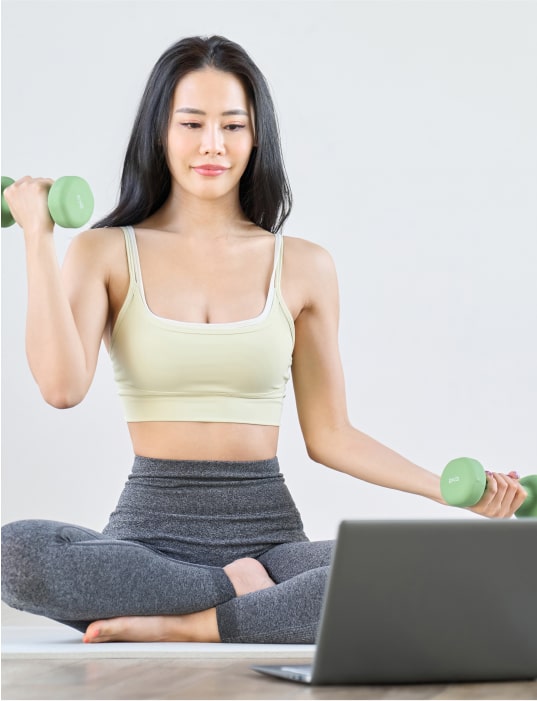Are You Earning Up to Your Potential?
Most personal trainers are undervaluing their time and skills. Our Personal trainer Revenue Calculator helps you find out what you should be making, and how to get there.
No guesswork. Just real numbers.
.jpg)
Introduction:
In the fitness world, one workout strategy stands out for its simplicity and effectiveness—High-Intensity Interval Training (HIIT). This blog breaks down the science behind HIIT, focusing on how it works and why it's a game-changer for personal trainers and their clients.
The Science Behind HIIT:

HIIT is like a fitness magic trick. Instead of exercising at a steady pace, you alternate between short bursts of intense activity and rest. The science here is straightforward: during the intense parts, your heart works hard, and during the rest between intense intervals, it catches its breath. This helps boost your overall fitness in a shorter time.
Improved Heart Health:
- HIIT makes the heart stronger by pumping more blood during the intense parts. It's like a workout for your heart, helping it get better and stronger.
- Studies say it's even better than the regular cardio we're used to.
Burn More Fat:
- HIIT has an excellent effect called afterburn. Even after you finish your workout, your body keeps burning calories, helping you lose fat.
- The quick bursts in HIIT use up stored fat for energy, making it an excellent fat-burning tool.
Speeds Up Metabolism:
- HIIT boosts your metabolism, which is like your body's calorie-burning engine. It keeps burning calories even after you're done with your workout, helping with weight control.
- It also helps your body handle sugar better, lowering the risk of diabetes.
Quick and Efficient:
- HIIT workouts are quick and don't take much time. Even though they're short, they are as good as, if not better, longer workouts.
- This is great for busy people who still want to stay fit.
Keeps Your Muscles:
- While regular cardio might make you lose some muscles, HIIT helps keep them.
- It's like a double win—you burn fat and keep your muscles toned.
Critical Elements of Effective HIIT Workouts:

Work and Rest Balance:
- Finding the right balance between working hard and resting is essential in HIIT. You exercise hard for a short time and then take a breather.
- Commonly, people do 30 seconds of hard work followed by 30 seconds of rest. It's like a rhythm that can fit different fitness levels.
Go Hard but Stay Safe:
- The "high-intensity" part is vital. You need to work hard but always stay safe. Whether running fast, jumping, or lifting weights, make sure it's challenging but doable.
- It's about finding the right balance so your clients push themselves without risking injuries.
Make It Tougher Gradually:
- You can make the workouts a bit tougher as your clients get fitter. Increase the intensity or workout time slowly to keep the challenge alive.
- Variety is vital, so mix up exercises to keep things interesting.
Also read: Full Body Circuit Workout and Its Benefits
💪 Got an idea for a brand? Let's bring it to life.
Launch your own fitness app with FitBudd in minutes!

💪 Got your brand name? Let’s bring it to life.
Launch your own fitness app with FitBudd in minutes!


88% trainers worldwide gave us 5 stars
Transform your fitness business with the power of your branded app on iOS and Android.
Try for FREEHIIT for Everyone: Adapting Workouts for Seniors, Pregnant Individuals, and Those with Medical Conditions or Injuries

High-intensity interval Training isn't reserved for the young and athletic. It's a versatile workout that can be adapted for seniors, pregnant individuals, and those with medical conditions or injuries.
Seniors:
- Adapt HIIT for seniors by incorporating lower-impact exercises and extending rest intervals.
- Focus on controlled movements, such as brisk walking, stationary cycling, or modified bodyweight exercises.
- Prioritize cardiovascular health while ensuring the workout remains accessible and safe for seniors.
Pregnant Individuals:
- Modify HIIT routines for pregnant individuals, emphasizing lower-impact movements to avoid excessive stress on the abdominal area.
- Adjust the intensity to a moderate level to ensure safety during pregnancy.
- Consult healthcare providers and fitness professionals for personalized guidance based on gestational stage and individual needs.
Those with Medical Conditions or Injuries:
- Tailor HIIT routines for individuals with medical conditions or injuries by adjusting intensity, duration, and exercise types.
- Consider incorporating moderate-intensity continuous training (MICT) for those with cardiovascular issues.
- Focus on low-impact alternatives to avoid impact and stress on injured areas.
- Consult healthcare professionals before starting a HIIT routine to ensure safety and alignment with individual health needs.
General Considerations:
- Prioritize safety and individual needs when adapting HIIT for diverse populations.
- Seek professional guidance to customize HIIT routines, especially for individuals with existing medical conditions.
- Highlight the versatility of HIIT, showcasing its potential to promote cardiovascular health and overall fitness across various fitness levels and health conditions.
Boost Your HIIT Workout Experience: Essential Equipment, Accessories, Apps, and Wearables

Enhancing your High-Intensity Interval Training (HIIT) experience goes beyond just the workout routine. The right equipment, accessories, apps, and wearables can elevate your sessions, ensuring you get the most out of your aerobic exercise and cardiovascular fitness goals while incorporating elements of aerobic fitness like sprint interval training and exercise intensity.
Essential Equipment:
- Dumbbells and Kettlebells: Incorporating weights into your HIIT program adds resistance, intensifying your workout and promoting strength.
- Resistance Bands: These versatile bands enhance muscle engagement and can be adjusted to various intensities, accommodating different fitness levels.
- Jump Rope: Ideal for incorporating cardio bursts, a jump rope is a simple yet effective tool to boost your heart rate during HIIT sessions.
Accessories:
- Yoga Mat: A comfortable mat enhances your overall workout experience for floor exercises and stretches.
- Interval Timer: Set intervals for work and rest phases easily with a timer to keep your HIIT routine structured and on track.
- Heart Rate Monitor: Track your heart rate during sessions to gauge exercise intensity and ensure you're hitting your cardiovascular fitness goals.
Apps:
- HIIT Apps: Numerous apps offer pre-programmed HIIT routines, making it convenient to follow structured workouts.
- Fitness Trackers: With your HIIT program, fitness trackers monitor your progress, providing insights into calorie burn and exercise intensity.
- Breathing Apps: Integrating deep breathing exercises into your HIIT routine can enhance recovery and manage stress, promoting a holistic approach to fitness.
Wearables:
- Smartwatches: Wearables like smartwatches can provide real-time data on your heart rate, allowing you to adjust exercise intensity based on your fitness goals.
- Bluetooth Headphones: Elevate your HIIT experience with music or guided workouts, enhancing motivation and focus during sessions.
Incorporating these elements into your fitness routine ensures your HIIT program is well-rounded and tailored to your needs.
Also read: If You Weight-Lift One Hour a Day, This Is What Will Happen to Your Body
Fueling Your High-Intensity Exercise: The Importance of Nutrition, Hydration, and Supplements

Proper fueling is paramount when engaging in High-Intensity Interval Training (HIIT). Balancing nutrition, hydration, and, when necessary, supplements is crucial to support moderate-intensity exercise and intense workouts within your HIIT sessions. Let's explore the significance of each aspect in maximizing the health benefits of your fitness routine.
Nutrition:
-Pre-Workout:
- Carbohydrates: Consuming complex carbs before your HIIT workout provides a readily available energy source, supporting intense exercise.
- Proteins: Including a moderate amount of protein aids in muscle preservation and provides sustained energy.
-Post-Workout:
- Proteins: Consuming protein-rich foods or supplements post-HIIT helps muscle recovery and growth.
- Carbohydrates: Replenish glycogen stores with carbs to restore energy levels.
- Staying well-hydrated is vital for both moderate-intensity exercise and high-intensity sessions.
- Proper hydration supports cardiovascular endurance and aids in maintaining optimal performance during HIIT workouts.
- Ensure consistent water intake throughout the day and pay attention to fluid needs during and after HIIT sessions.
Supplements:
- Electrolytes: Especially beneficial for longer HIIT sessions, electrolyte supplements can help maintain fluid balance and prevent dehydration.
- Branch-Chain Amino Acids (BCAAs): BCAAs aid in muscle recovery and can be beneficial during and after HIIT, particularly for intense exercise.
- Creatine: Known for enhancing strength and power, creatine supplementation may benefit individuals incorporating resistance training into their HIIT routine.
Balancing your nutrition, staying hydrated, and considering supplements when needed can optimize your own HIIT training experience. Whether engaging in high-intensity interval training or moderate-intensity exercise within your routine, the right fuel ensures you perform at your best. Additionally, supporting factors like cardiovascular endurance, insulin sensitivity, and muscle preservation are integral to your overall fitness journey. Remember, a well-nourished body performs better during HIIT sessions and recovers efficiently, promoting long-term health and fitness goals.
Embracing the Future of HIIT: Evolving Workouts, Holistic Fitness, and Preventive Health

High-intensity interval Training (HIIT) is not just a passing fitness trend; it's a dynamic approach that continues to evolve, incorporating new elements and insights from exercise training, sports medicine, and preventive health. As we look ahead, the future of HIIT involves evolving workouts, promoting holistic fitness, and contributing to preventative health measures.
Evolving Workouts:
- Continuous Endurance Training Integration: Combining HIIT with ongoing endurance training provides a comprehensive approach, catering to both aerobic capacity and muscular endurance. This hybrid model incorporates the best of both worlds, enhancing cardiovascular health and overall fitness.
- Muscle Group Variation: Future HIIT workouts will likely target different muscle groups, ensuring a balanced and full-body approach. Varied exercises engage diverse muscle groups, promoting overall strength and reducing the risk of overuse injuries.
- Active Recovery: Integrating busy recovery periods within HIIT sessions enhances muscle recovery and reduces fatigue. This evolution acknowledges the importance of proper recovery for sustained performance and long-term fitness.
Holistic Fitness:
- Holistic Approach by Personal Trainers: Personal trainers are increasingly adopting a holistic approach, considering the intensity of HIIT exercises and the appropriateness of movements for individual clients. This personalized touch ensures tailored workouts that align with specific fitness goals and overall well-being.
- Weight Loss and Fat Loss Goals: HIIT's efficacy in weight and fat loss remains a focal point. Evolving HIIT workouts are likely to address different aspects of weight management, emphasizing appropriate exercises for each individual's fitness level.
- Sports Medicine Integration: Collaborations with sports medicine experts contribute to the future of HIIT, ensuring that workouts are designed with considerations for skeletal muscle health, blood pressure regulation, and the prevention of cardiovascular diseases.
Preventive Health:
- Regular HIIT Workouts for Preventive Health: Consistent engagement in HIIT has shown promise in preventing cardiovascular disease. Future emphasis may include advocating regular HIIT sessions as a preventive measure for maintaining heart health.
- Aerobic Capacity Enhancement: The future of HIIT will likely strongly emphasize enhancing aerobic capacity. This involves high-intensity intervals and structured programs that gradually increase intensity, ensuring sustained improvements in cardiovascular endurance.
- Incorporating Active Recovery: Integrating active recovery periods within HIIT sessions contributes to preventive health by promoting flexibility, reducing the risk of injuries, and supporting long-term exercise adherence.
As the HIIT and fitness industry continues to evolve, it remains a powerful tool for achieving fitness goals, providing efficient workouts that contribute to overall health and well-being. The future of HIIT involves a holistic and preventive approach, acknowledging the importance of tailored workouts, varied exercises, and collaboration with fitness professionals and experts in related fields.
Conclusion:
For fitness trainers, understanding the simplicity and effectiveness of HIIT can unlock a realm of possibilities for their clients. By comprehending the science behind HIIT and incorporating critical elements like balanced work and rest, safe intensity, and gradual progression, trainers can guide clients toward transformative and enjoyable workouts. With HIIT, it's not just about the sweat; it's about working smarter to achieve exceptional results. As we adapt HIIT for everyone, embrace essential tools, fuel our bodies right, and evolve our approach, we pave the way for a future where a HIIT session isn't just a workout but a holistic path to a healthier, more vibrant life.
Related posts:
Insanity vs HIIT: What's the Difference?
Mental Health and Fitness: Explore the connection between mental health and physical fitness.
Free Workout Plan for Men & Women
Exercise Routine for Beginners
Frequently Asked Questions

Creative Fitness Challenges Ebook
Discover exciting challenges to boost your workouts and keep your fitness journey thrilling.
Download Now
Templates
These functional templates have the power to make any fitness trainer's life easier.
Subscribe To
Our Blog




















.png)












